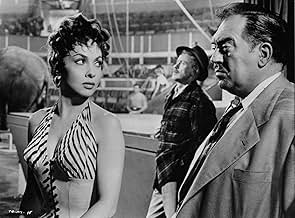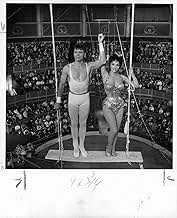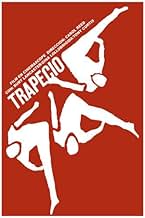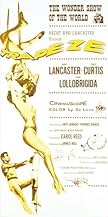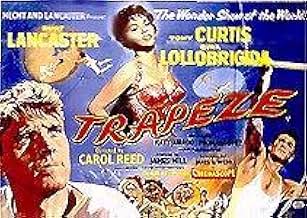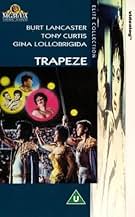VALUTAZIONE IMDb
6,8/10
5582
LA TUA VALUTAZIONE
Aggiungi una trama nella tua linguaA crippled circus acrobat is torn emotionally between two ambitious young trapeze artists, one a talented young American and a less-gifted but beautiful Italian.A crippled circus acrobat is torn emotionally between two ambitious young trapeze artists, one a talented young American and a less-gifted but beautiful Italian.A crippled circus acrobat is torn emotionally between two ambitious young trapeze artists, one a talented young American and a less-gifted but beautiful Italian.
- Regia
- Sceneggiatura
- Star
- Premi
- 3 vittorie e 2 candidature totali
Johnny Puleo
- Max
- (as John Puleo)
Gérard Landry
- Chikki
- (as Gerard Landry)
Jean-Pierre Kérien
- Otto
- (as Jean-Pierre Kerien)
Serge Bento
- Circus Boy
- (non citato nei titoli originali)
- …
Paul Bonifas
- Paul - Circus Peddler
- (non citato nei titoli originali)
Roland Carey
- Trapeze Artist
- (non citato nei titoli originali)
Recensioni in evidenza
Burt Lancaster, Tony Curtis, and Gina Lollbrigida star in "Trapeze," which depicts the life of trapeze artists in a circus. Tony Curtis wants to be a great trapeze artist and thinks he's ready for it, except for one thing, the triple somersault. And, he needs Burt Lancaster to teach him. But, Burt has quit the spotlight since he tried the triple and fell. But, when he sees Tony and what he can do, he thinks Tony can do a triple. But, he won't tell him so, at first. Enter Gina. She has a wire act of her own, and she want to get in on the main attraction. And, of course, love enters the picture.
This may have a why should I care? feel to it, as it may not interest some people at all. But for those who will be watching for the stars, the rewards are many. This is a more personal and realistic (of course how should I know) story and treatment of what goes on beyond the high wire act than Cecil B. DeMille's "The Greatest Show on Earth." We are allowed to see beyond the glamorous lifestyle and see them as people who are trying to express themselves while existing here on this earth. This has a deep respect for its subject matter and its characters and shows how they have to work together in order for the act to work, and not just because of the obvious physical risks involved but because they are supposed to be a team and not looking out only for themselves.
Plus, Lancaster apparently had some experience in this and performed most of his stunts, and, after Tony and Gina practiced a lot, they did as much as they could. So you do get the real thing and some really good and sincere performances.
If you want less DeMille-like glitz and more substance, then this is the circus for you.
This may have a why should I care? feel to it, as it may not interest some people at all. But for those who will be watching for the stars, the rewards are many. This is a more personal and realistic (of course how should I know) story and treatment of what goes on beyond the high wire act than Cecil B. DeMille's "The Greatest Show on Earth." We are allowed to see beyond the glamorous lifestyle and see them as people who are trying to express themselves while existing here on this earth. This has a deep respect for its subject matter and its characters and shows how they have to work together in order for the act to work, and not just because of the obvious physical risks involved but because they are supposed to be a team and not looking out only for themselves.
Plus, Lancaster apparently had some experience in this and performed most of his stunts, and, after Tony and Gina practiced a lot, they did as much as they could. So you do get the real thing and some really good and sincere performances.
If you want less DeMille-like glitz and more substance, then this is the circus for you.
Carol Reed was one of Britain's most interesting directors, and perhaps most intriguing about his work is his unique brand of stylised realism, the two conflicting moods astutely and unforgettably blended: the handsome, dream-like snow-storm in 'Odd Man Out (1947)'; the woozy war-torn streets of Vienna in 'The Third Man (1949)'; the blending of fantasy against a working-class London background in 'A Kid for Two Farthings (1955).' With 'Trapeze (1956),' Reed deliberately contrasts his use of fantasy and realism. The circus had long held an element of prestige, having spawned a tidy sub-genre of its own, encompassing everything from Lind's 'The Flying Circus (1912)' to DeMille's 'The Greatest Show on Earth (1952).' For decades, the circus has entertained the masses with daring acts of strength and bravery, dangerous animals and extraordinary human performers. But behind this glamour is a less enchanting side of the circus – endless practice sessions, money-hungry managers, and scheming performers who'd place their own interests before those whose lives are being placed in their hands nightly. 'Trapeze' deals with the collision of these two conflicting worlds.
Mike Ribble (Burt Lancaster) was once a great "flyer" of the trapeze, one of the few men who could execute a triple somersault. However, a tragic accident left him with a permanent limp, and Mike has since lost all interest in the sport he once dominated. That, at least, is until Tino Orsino (Tony Curtis) arrives in Paris, a keen acrobat who seeks Mike's expert instruction. That Ribble eventually agrees to the partnership is, of course, a given, and their ultimate accomplishments are never in any doubt, but the interplay between Lancaster and Curtis is authentic and entertaining. Reed depicts the indomitable circus prestige through audience applause and the cheerful melody of the "Blue Danube" waltz. When the antagonism being played out behind-the-scenes inexorably spills out into the performing arena, both the applause and the music comes to a standstill. Thus, interjecting into this fantasy world comes the realisation that the circus performers are only human. The reality suddenly becomes clear: one mistake will spell almost certain death.
Though Mike and Tino make a formidable team, a romantic complication arises in Lola (Gina Lollobrigida), an ambitious acrobat who'd betray her friends and promise love to anybody whom she thought could aid her career. Lola's exploits are contemptible throughout the film, garnering little sympathy from the audience; one might even suggest that the beating she receives at the hands of her former partners is almost justified by her actions. In any case, the film's conclusion is far too kind to her. Lola chases Mike down a quiet Paris street, perhaps a complementary allusion to Holly Martin's shameful snubbing in the final moments of 'The Third Man (1949).' Maintaining the optimism that Reed displayed previously in 'A Kid for Two Farthings,' this ending offers redemption rather than disgrace to Lola, who is seen to have betrayed her companions, much as Martins betrayed Harry Lime and Anna Schmidt. Most impressive of all is Robert Krasker's creative photography, frequently offering the audience a breathtaking "birds-eye" view of the trapeze routines, like leaning over a precipice into open space.
Mike Ribble (Burt Lancaster) was once a great "flyer" of the trapeze, one of the few men who could execute a triple somersault. However, a tragic accident left him with a permanent limp, and Mike has since lost all interest in the sport he once dominated. That, at least, is until Tino Orsino (Tony Curtis) arrives in Paris, a keen acrobat who seeks Mike's expert instruction. That Ribble eventually agrees to the partnership is, of course, a given, and their ultimate accomplishments are never in any doubt, but the interplay between Lancaster and Curtis is authentic and entertaining. Reed depicts the indomitable circus prestige through audience applause and the cheerful melody of the "Blue Danube" waltz. When the antagonism being played out behind-the-scenes inexorably spills out into the performing arena, both the applause and the music comes to a standstill. Thus, interjecting into this fantasy world comes the realisation that the circus performers are only human. The reality suddenly becomes clear: one mistake will spell almost certain death.
Though Mike and Tino make a formidable team, a romantic complication arises in Lola (Gina Lollobrigida), an ambitious acrobat who'd betray her friends and promise love to anybody whom she thought could aid her career. Lola's exploits are contemptible throughout the film, garnering little sympathy from the audience; one might even suggest that the beating she receives at the hands of her former partners is almost justified by her actions. In any case, the film's conclusion is far too kind to her. Lola chases Mike down a quiet Paris street, perhaps a complementary allusion to Holly Martin's shameful snubbing in the final moments of 'The Third Man (1949).' Maintaining the optimism that Reed displayed previously in 'A Kid for Two Farthings,' this ending offers redemption rather than disgrace to Lola, who is seen to have betrayed her companions, much as Martins betrayed Harry Lime and Anna Schmidt. Most impressive of all is Robert Krasker's creative photography, frequently offering the audience a breathtaking "birds-eye" view of the trapeze routines, like leaning over a precipice into open space.
Curtis was young...Lancaster was in his prime.....The trapeze performances were stunning and despite the predictability of the story, Trapeze was a wonderful movie. Though a little "hokey" at times, and dated perhaps today, the warmth, sincerity, and circus-realism makes this a mild classic!
What can we say about the big guy? He did his own stunts and this little film with Tony "Yonder's m'fadda's castle" Curtis [né Schwartz] and the lovely Ms. Lollobrigida, along with vet character actor Tom Gomez, delivers. Lots of fun. Lots of stunts. A reminder of a long gone era when movies had something to say. I remember seeing this one in San Francisco when it first aired. My date that evening was beautiful El Salvadorian who looked (nearly) as gorgeous as Gina. But, the film was so good, I stayed on my best behavior, much to her (and my) surprise. Ah, those were the days and this was a fun film to watch. The scene where Curtis and Lancaster walk home on their hands alone was worth the price of admission-- for both of us.
Enjoyed this great 1956 Classic film starring Burt Lancaster, (Mike Riddle) who gave an outstanding performance as an experienced trapeze artist. In real life, Burt left Northwestern University in Evanston, Illinois in his second year and decided to join a circus and traveled all around performing on the high wires. As Burt's movie career became successful, he had the opportunity to make this picture which he had longed to do for many years. Burt teams up with Tony Curtis, (Tino Orsini) who gave a great supporting role along with the beautiful Gina Lollobrigida, (Lola) who added her great charm to this picture and had two men fighting over her for her love. Thomas Gomez,(Bouglione) was the circus manager and gave an outstanding performance to his role as a man who ran his circus with an iron fist. This is a great picture with great veteran actors, enjoy.
Lo sapevi?
- QuizThe 41-year-old Burt Lancaster performed all but one of the trapeze stunts himself, having worked in a circus before entering films. He insisted on doing the climactic triple somersault, but technical adviser Eddie Ward initially was hesitant on Lancaster performing the stunt, and Ward doubled for him during the first weeks of shooting. Director Sir Carol Reed eventually hired Lancaster's longtime friend, stuntman Nick Cravat to perform the stunt.
- Citazioni
Tino Orsini: You know, I always modeled my style after yours.
Mike Ribble: You'll always be a second-rater. Make your own style!
- ConnessioniFeatured in Cento e una notte (1995)
- Colonne sonoreThe Blue Danube (An der schönen, blauen Donau, Op. 314)
(uncredited)
Music by Johann Strauss
Played during the trapeze routines
I più visti
Accedi per valutare e creare un elenco di titoli salvati per ottenere consigli personalizzati
- How long is Trapeze?Powered by Alexa
Dettagli
- Data di uscita
- Paese di origine
- Lingue
- Celebre anche come
- Trapeze
- Luoghi delle riprese
- Cirque d'Hiver - 110 rue Amelot, Paris 11, Parigi, Francia(picture photographed at)
- Aziende produttrici
- Vedi altri crediti dell’azienda su IMDbPro
Botteghino
- Budget
- 4.000.000 USD (previsto)
- Tempo di esecuzione
- 1h 45min(105 min)
- Colore
- Proporzioni
- 2.35 : 1
Contribuisci a questa pagina
Suggerisci una modifica o aggiungi i contenuti mancanti


